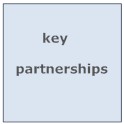 Section
Navigation
Section
Navigation
8. Models and Strategy
8.1 eBusiness in Context: US Scene
8.2 Strategic Management
8.3 Grouping by Strategy
8.4 Business Models
8.5 Customer Segments
8.6 Customer Channels
8.7 Customer Relationships
8.8 Key Resources
8.9 Key Partnerships
8.10 Key Activities
8.11 Value Propositions
8.12 Cost Structure
8.13 Revenue Streams
8.14 Internet Revenue Models
8.15 Strategy
8.16 Company Valuation
8.17 Measures & Ratios
8.18 Fundamental Analysis
8.19 Efficient Markets
8.20 Neoclassical Economics
 8.9
Key Partnerships
8.9
Key Partnerships
Key Partnerships are the network of suppliers and partners that make the
business model work. Companies forge partnerships to optimize their business
models, reduce risk, and/or acquire resources. Four types of partnerships
are commonly distinguished:
 |
1. Strategic alliances between non-competitors. 2. Competition: strategic partnerships between competitors. 3. Joint ventures to develop new businesses. 4. Buyer-supplier relationships to assure reliable supplies. |
1. Optimization and economy of scale
Here the object is the best allocation of resources and activities. Since a company rarely owns all the resources needed to perform every activity by itself, it enters into partnerships with companies who can supply at optimal cost.
2. Reduction of risk and uncertainty
Partnerships can reduce risk in uncertain environments. Competitors often form a strategic alliance in one area while competing in another. Blu-ray, for example, is an optical disc format jointly developed by a group of the world's leading consumer electronics, personal computer, and media manufacturers. The group cooperated to bring Blu-ray technology to market, but individual members compete in selling their own Blu-ray products.
3. Acquisition of particular resources and activities
Companies extend their own capabilities by relying on other firms to furnish particular resources or perform certain activities. Resources may include knowledge, licenses, or access to customers. A mobile phone manufacturer may license an operating system for its equipment rather than developing one in-house. An insurer may find it better to rely on the competition of independent brokers to sell its policies rather than develop its own sales force.
Internet Approaches and Technology
eProcurement facilitates digital sale and purchase of supplies.
Private Industrial Networks coordinate transactions between specific companies.
Relevant Case Studies
eBay forged relationships with 60 website, including AOL and PayPal.
Proctor & Gamble 'Connect & Develop' policy expanded internal research through outside partnerships.
GlaxoSmithKline operates closely with the FDA.
Fiat links to key suppliers through private industrial networks.
Wal-mart has key partnerships with suppliers.
PayPal has a key partner in eBay.
Dutch flower growers have a key partner in Eneco.
Zipcar has key partnerships with environmentally-conscious city authorities.
By using a business model, Ronald Chan identified three new key partners.
 Questions
Questions
1. What are key partnerships? How do they differ from customer segments?
2. Name the four types of key partnership.
3. Describe the three motivations applying to key partnerships.
4. Describe key partnerships in action with two case studies
 Sources
and Further Reading
Sources
and Further Reading
1. Business Model Generation: A Handbook for Visionaries,
Game Changers, and Challengers. by Alexander Osterwalder and Yves Pigneur.
Wiley 2010.